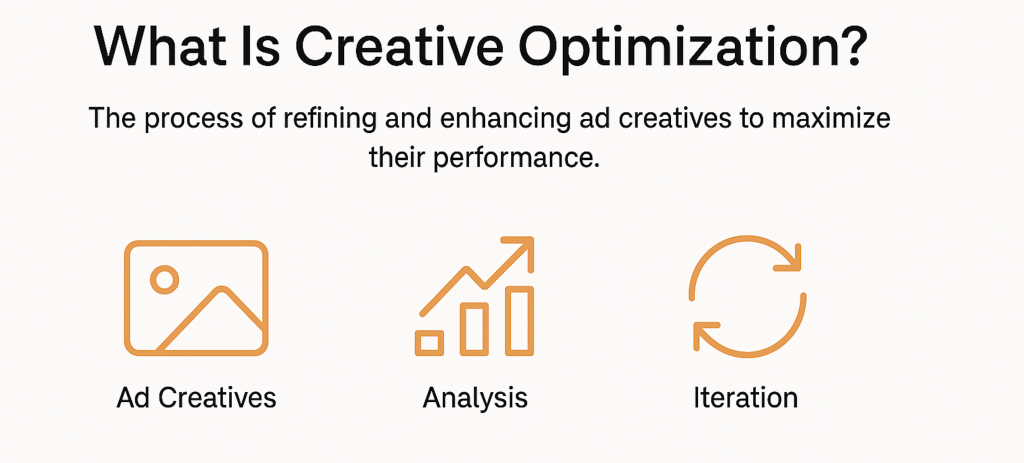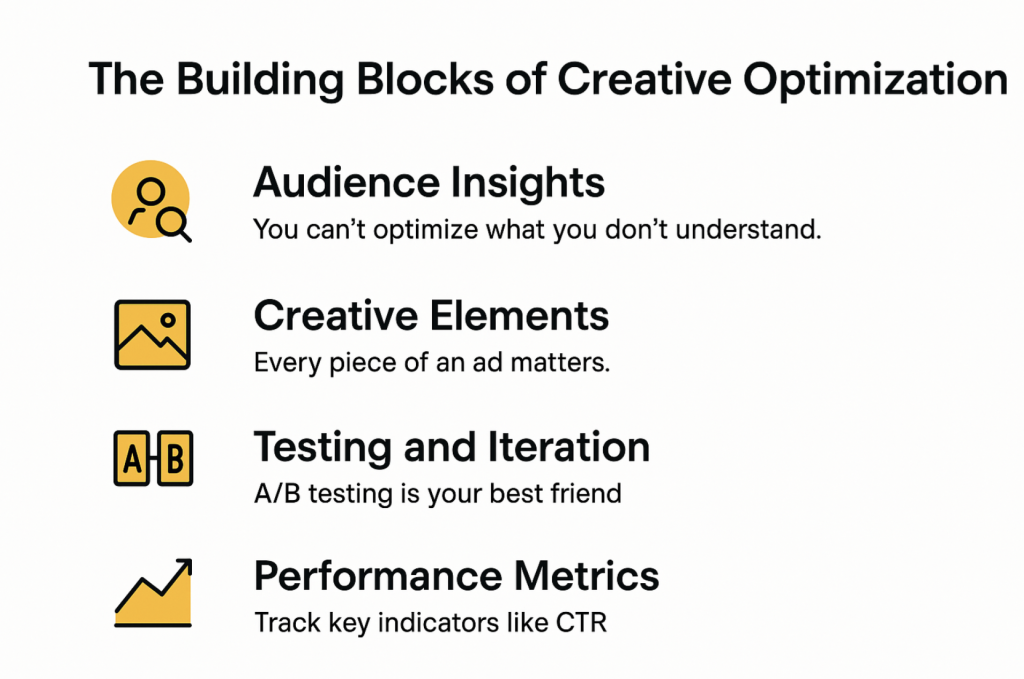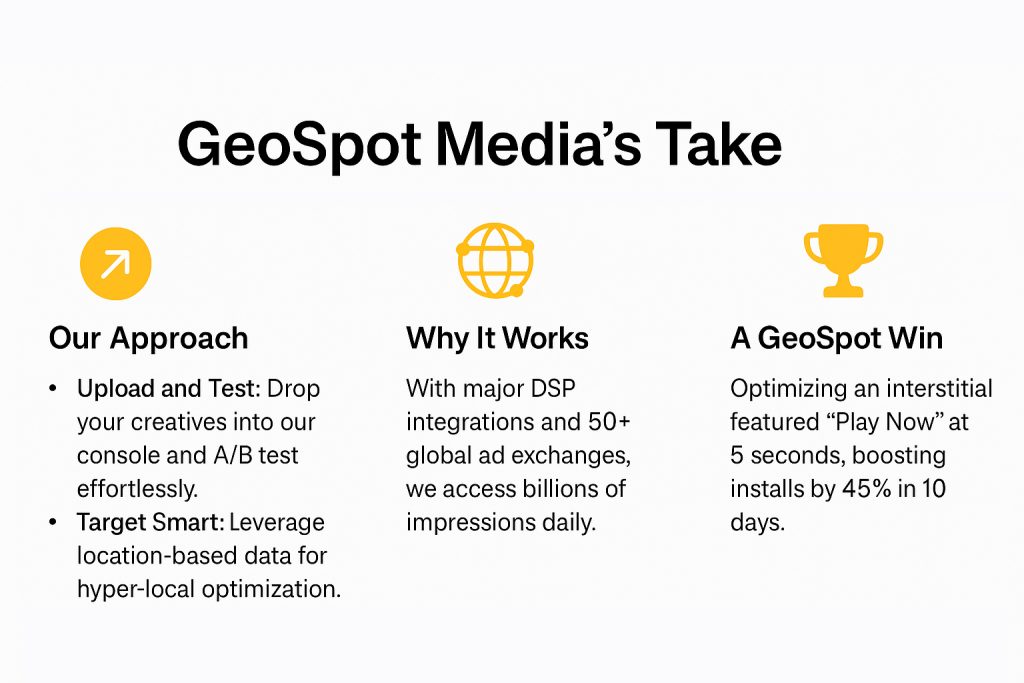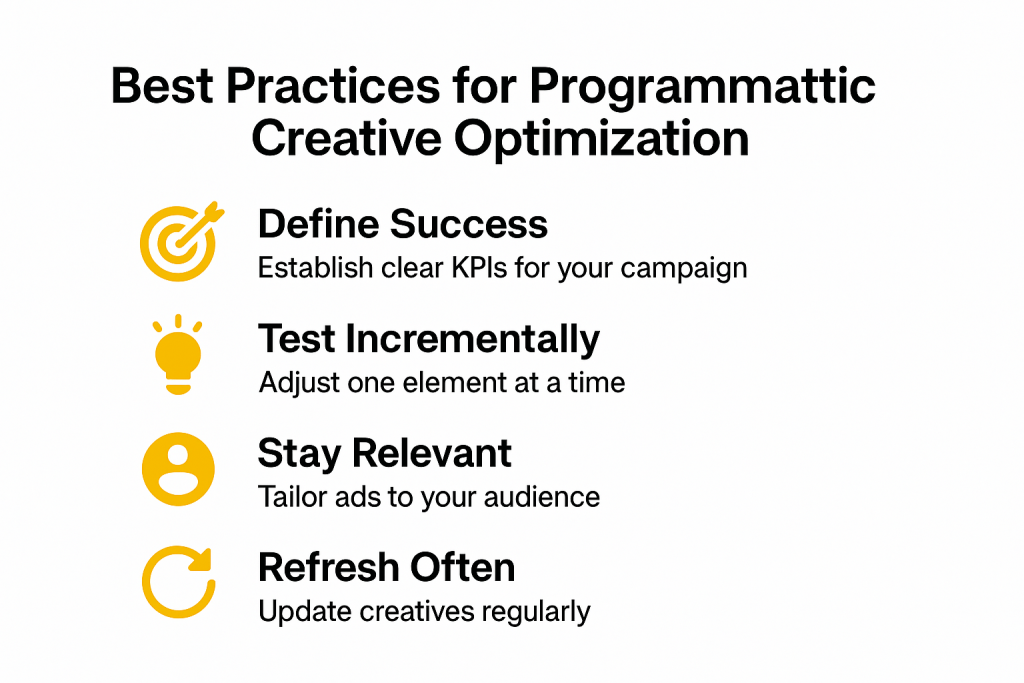Creative Optimization Boosts Programmatic Success
In today’s fast-paced digital landscape, where consumers are bombarded with thousands of ads daily, standing out is no small feat. Enter creative optimization—the art and science of crafting advertisements that don’t just capture attention but inspire action. It’s about more than just pretty visuals or catchy taglines; it’s a strategic process that blends data, creativity, and technology to deliver the right message to the right audience at the right time. At GeoSpot Media, we’ve seen firsthand how creative optimization can transform campaigns, driving higher engagement, better ROI, and lasting brand loyalty.
This blog dives deep into what creative optimization entails, why it matters, and how businesses can harness it to elevate their advertising game. We’ll explore actionable strategies, real-world examples, and even share our approach to making creative optimization work for you. Whether you’re a marketer, a business owner, or just curious about the future of advertising, this guide is your roadmap to creating ads that resonate.
What Is Creative Optimization?

At its core, creative optimization is the process of refining and enhancing ad creatives—think banners, videos, native ads, or push notifications—to maximize their performance. It’s not a one-and-done task but an ongoing cycle of testing, analyzing, and iterating. The goal? To ensure every element of an ad, from the headline to the call-to-action (CTA), aligns with audience preferences and campaign objectives.
Imagine you’re launching a campaign for a new fitness app. You’ve got a sleek banner ad with a bold “Sign Up Now” button, but after a week, the click-through rate (CTR) is underwhelming. Creative optimization steps in here—maybe the button color blends into the background, or the message doesn’t speak to your audience’s motivations (like “Get Fit in 30 Days” instead of a generic prompt). By tweaking these elements based on data and feedback, you turn a mediocre ad into a conversion machine.
This process isn’t just guesswork. It leverages analytics, and A/B testing, to uncover what works. It’s where creativity meets precision, ensuring your ads don’t just look good—they perform brilliantly.
Why Creative Optimization Matters
Let’s be real: the digital ad space is crowded. Studies suggest the average person sees between 6,000 and 10,000 ads daily. In that sea of noise, a poorly optimized creative is like a whisper in a storm—easily ignored. Creative optimization matters because it’s your ticket to cutting through the clutter. Here’s why:
- Cuts Through the Noise: With audiences exposed to thousands of ads daily, optimized programmatic creatives stand out—think a bold full-screen ad over a bland banner.
- Maximizes ROI: Higher CTRs and conversions mean your ad spend works harder, a critical edge in programmatic’s cost-per-impression model.
- Leverages Real-Time Data: Programmatic offers instant feedback—use it to refine creatives on the fly.
- Targets with Precision: Tailor ads to specific segments (e.g., urban commuters vs. rural shoppers) within the programmatic pipeline.
Consider a programmatic campaign for an e-commerce brand. A generic native ad might get impressions, but optimizing it to highlight “Free Shipping” for price-sensitive users in a specific geo-fence boosts conversions. Creative optimization ensures your programmatic buys aren’t just efficient—they’re effective.
The Building Blocks of Creative Optimization

So, how do you optimize a creative? It’s not magic—it’s methodical. Here are the key components:
1. Audience Insights
You can’t optimize what you don’t understand. Start with your audience. Who are they? What do they care about? Programmatic platforms provide precise data—age, location, interests, even device type. Use this to shape your creative direction.
Example: A skincare brand discovers their ads perform best with women aged 25–34 in urban areas. They tweak their visuals to feature city-dwelling millennials, not generic models, and watch engagement soar.
2. Creative Elements
Every piece of an ad matters:
- Visuals: Are images or videos eye-catching and relevant?
- Copy: Does the text inspire action or emotion?
- CTA: Is it clear and compelling?
- Design: Does the layout guide the eye naturally?
Test variations. Swap a red CTA button for a green one. Try “Join Today” versus “Start Now.” Small changes can yield big results.
3. Testing and Iteration
A/B testing is your best friend in creative optimization. Run two versions of an ad—say, one with a humorous tone and another with a serious one—and see which performs better. Iterate based on the winner, then test again. It’s a cycle of refinement.
4. Performance Metrics
Track key indicators like CTR, conversion rate, cost-per-click (CPC), and engagement time. These numbers tell you what’s working and what’s not. If a video ad has a high drop-off rate at 5 seconds, maybe the intro needs a punchier hook.
Creative Optimization in Action: Programmatic Examples
Let’s see it play out:
- The Retail Banner Boost: A fashion retailer runs programmatic banners with “Shop Now.” CTRs are average. Optimization swaps in “New Drop” and a bolder button. CTR climbs 35%—relevance wins.
- The Push Pivot: A food delivery app targets busy professionals with programmatic ads saying “Order Now.” Results lag. Optimizing to “Dinner in 15 Mins” with a time-sensitive geo-target doubles orders.
- The Interstitial Tune-Up: A gaming app uses interstitials in it’s programmatic campaign. Installs are low despite impressions. Moving the “Play Free” CTA earlier in the sequence lifts installs by 20%. Timing is everything.
These examples prove creative optimization in programmatic isn’t about overhauling—it’s about refining for impact.
Challenges in Programmatic Creative Optimization (And Solutions)

Creative optimization boosts programmatic campaigns, but its fast, data-heavy nature poses challenges. We tackle four key issues—data complexity, creative burnout, speed vs. quality, and tech dependence—with practical, real-world solutions.
1. Data Complexity: Navigating the Programmatic Data Deluge
Programmatic thrives on a flood of data—impressions, clicks, audience segments, and bid rates stream in constantly from Independent Trading Desks or DSPs and exchanges. This treasure trove fuels optimization but can overwhelm, leaving marketers lost in metrics like CTR by geo or CPA by device. Without focus, thousands of daily data points turn into noise, hiding what truly drives performance.
Solution: Anchor optimization to your campaign’s core KPI—CPA for sales, CTR for awareness—to cut through the clutter. Use Independent Trading Desks dashboards, like GeoSpot Media’s, to filter relevant metrics. Start small, analyzing one segment (e.g., urban mobile users), then scale. A retailer might spot high rural CPAs and optimize urban creatives with bolder visuals, simplifying data into action efficiently.
2. Creative Burnout: Keeping Audiences Engaged Amid High Frequency
Programmatic campaigns lean on frequent impressions to win auctions, but repeating the same banner or interstitial risks burnout. Viewers lose interest after 3–5 ad impressions, tuning out static ads as engagement drops fast—think a stellar day-one ad fading by day ten. In programmatic’s high-volume world, this fatigue hits harder and quicker.
Solution: Rotate creatives regularly to stay fresh, update copy (e.g., ‘Last Chance’ to ‘Act Now’), or tweak offers every 7–14 days. A/B test refreshes to spot what sustains momentum A car rental client saw a 20% engagement dip; switching to “Drive Free This Weekend” revived it by 15%. Variety keeps viewers hooked, not bored.
3. Speed vs. Quality: Balancing Programmatic’s Pace with Creative Polish
Programmatic moves fast—ads serve in milliseconds, demanding quick creative tweaks mid-campaign. Rushing risks sloppy work, like blurry banners, which tank CTR and hurt brand trust. An urgent ad update might arise, yet a poorly timed tweak could backfire, diminishing programmatic’s streamlined strengths.
Solution: Use pre-approved templates—standard layouts with swappable text or images—for fast, polished updates. A retailer might swap “20% Off” for “Free Shipping” in minutes using a banner base. Pre-build a library of assets with your team to pivot seamlessly. GeoSpot Media’s platform supports this—upload a batch, test, and deploy winners fast, keeping quality high.
4. Tech Dependence: Avoiding the Automation Creativity Trap
Programmatic relies on tech—Independent Tradign Desks or DSPs and dynamic tools streamline optimization—but leaning too hard on it can sap creativity. Automation might tweak a CTA’s color for a 2% CTR boost, yet miss the human touch—like a clever tagline—that truly connects. Over-optimization can churn out bland ads in programmatic’s scale-driven rush.
Solution: Let tech guide, not rule. Start with human-crafted ideas—a bold story or hook—then refine with data. If “Learn More” flops, test “Unlock Now” for curiosity, not just new shades. A gaming client’s generic “Play Now” ads faltered; we added “Be the Hero,” lifting installs 30%. Blend human flair with programmatic precision for impact.
GeoSpot Media’s Take

At GeoSpot Media, creative optimization isn’t a buzzword—it’s our bread and butter. We’ve built a programmatic platform that puts creative control in your hands. Here’s how we do it, and how you can tap in:
Our Approach
We specialize in programmatic formats—banners, interstitials, native, and video—offering tools to:
- Upload and Test: Drop your creatives into our console and A/B test effortlessly.
- Target Smart: Leverage location-based data for hyper-local optimization.
- Track Live: Get real-time analytics across impressions, clicks, and conversions.
Why It Works
With major DSP integrations and 50+ global ad exchanges, we access billions of impressions daily. Our transparent, user-friendly platform lets you optimize programmatic creatives with precision—whether it’s tweaking a banner’s CTA or refreshing a native ad’s copy.
A GeoSpot Win
A client in the mobile gaming space ran programmatic interstitials with high impressions but low installs. We analyzed the data, spotting a late CTA. Optimizing the creative to feature “Play Now” at the 5-second mark, paired with geo-targeted gamer hotspots, boosted installs by 45% in 10 days. That’s programmatic creative optimization at its best.
How to Use GeoSpot Media
Start by uploading creatives via our UI or API. Set your audience (geo, behavior, device), launch, and refine based on live data. Our 24/7 global support has your back. Check our Creative Management document for the full rundown.
Best Practices for Programmatic Creative Optimization

Mastering creative optimization in programmatic advertising requires a strategic playbook. These five best practices will guide you to craft standout creatives that leverage the power of automation, data, and human insight. Whether you’re aiming for clicks, conversions, or brand lift, here’s how to optimize programmatically with precision and impact.
1. Define Success
Start by pinpointing your campaign’s goal—success in programmatic hinges on clear KPIs. For brand awareness, focus on click-through rate (CTR) to gauge engagement; for sales, track cost-per-acquisition (CPA) to measure efficiency. Clarity here directs your creative optimization efforts, ensuring every tweak aligns with what matters most—whether it’s impressions, clicks, or revenue.
2. Test Incrementally
Optimize one element at a time to isolate what drives results—don’t overhaul everything at once. Test copy first (e.g., “Shop Now” vs. “Save Today”), then visuals or CTAs. This methodical approach, rooted in A/B testing, reveals winners clearly, letting you scale changes confidently without complicating the insights from your programmatic campaign.
3. Stay Relevant
Tailor creatives to programmatic audience segments—urban users might crave fast-paced ads, while rural ones prefer simplicity. Match mobile creatives with bold visuals and desktop ones with detailed copy. Relevance boosts engagement by speaking directly to behaviors and contexts, making creative optimization a precision tool in the vast programmatic landscape.
4. Refresh Often
Combat creative fatigue in high-frequency programmatic buys by keeping ads dynamic. Rotate visuals, update copy (e.g., “Last Chance” to “Act Now”), or tweak offers every 7–14 days. Freshness prevents audience burnout, sustaining performance as impressions pile up—crucial for creative optimization in the relentless pace of programmatic advertising.
Conclusion
Creative optimization is the heartbeat of successful programmatic advertising. In a digital world where attention is scarce and competition fierce, it’s the difference between ads that fade into the background and those that spark action. By blending audience insights, iterative testing, and smart technology, you can craft programmatic creatives that don’t just reach the right people—they resonate deeply. From tackling data complexity to keeping ads fresh, the strategies and examples we’ve explored show how small refinements yield big wins—higher engagement, better ROI, and stronger connections.
At GeoSpot Media, we’re passionate about turning this potential into reality. Our platform and expertise empower you to optimize with precision, delivering campaigns that shine in the programmatic spotlight. Whether you’re refining a banner’s CTA or targeting a geo-specific audience, creative optimization is your edge. Ready to transform your next campaign? Dive in with us—let’s make your ads unforgettable.




Post Comment